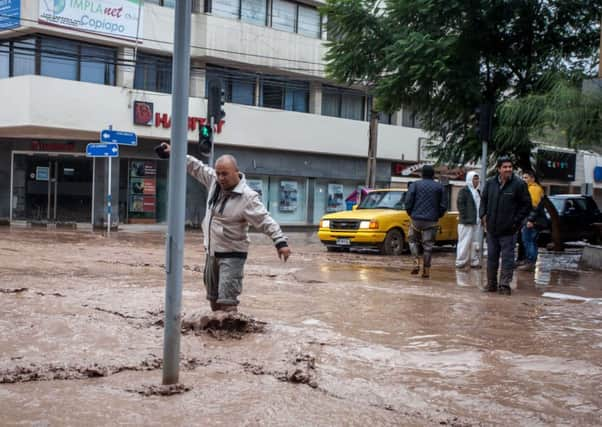Chile’s ‘bone dry’ Atacama desert hit by floods


Chile’s government declared a state of emergency in the Atacama desert after downpours – the heaviest in 80 years – cut off roads, knocked out electricity and threatened several communities in the usually bone-dry region.
Thunderstorms with torrential rains caused the Copiapo river to overflow its banks, forcing evacuations because of fears of mudslides. TV images showed brown, muddy waters flooding the streets and reaching a hospital in Copiapo city.
Advertisement
Hide AdAdvertisement
Hide AdChile’s national emergency office said nearly 61,000 people were without power and almost 50,000 did not have drinking water.
President Michelle Bachelet has travelled to the affected areas to help lead rescue efforts.
“We’re doing everything humanly possible to get to where [those affected] are as quickly as possible,” she said.
The military has also been deployed to Copiapo to help with the emergency.
Some people living alongside the river had to be rescued by helicopter because roads were blocked by water and mud, but some residents refused to leave their homes.
“Anyone in an at-risk zone in the Atacama region should evacuate,” interior minister Rodrigo Penailillo said.
“The weather situation is extremely complex. The report we have says that heavy rains will continue to fall in the area in the next eight hours.
“We’re asking the people of Atacama to self-evacuate to safe zones.”
Advertisement
Hide AdAdvertisement
Hide AdChile’s state-run copper giant, Codelco, said it was temporarily suspending mining operations in the area due to blocked roads, but added that flooding had not affected its sites, including the world’s largest open-pit copper mine.
The sudden autumn downpour came after an unusually hot, dry summer, which is said to have exacerbated an eight-year drought.
Experts say the unusual weather was caused by a cold front hitting the Andes.
Spurred by high temperatures, it produced strong rains instead of snow at the high altitudes. That rainwater then swept down to valleys and towns in the foothills.
Elsewhere in Chile, the dry conditions are continuing, with firefighters in the south tackling nearly 40 separate blazes that are burning across 14,000 hectares.
Earlier this week, Chile declared a national alert because of the wildfires in three national parks and reserves.
The fires were raging in the China Muerta National Reserve, Nalca Lolco National Reserve and Conguillio National Park in the southern region of Araucania, which has been hit by years of draught.
Trees, some of which are about 1,000 years old, were said to be under threat.